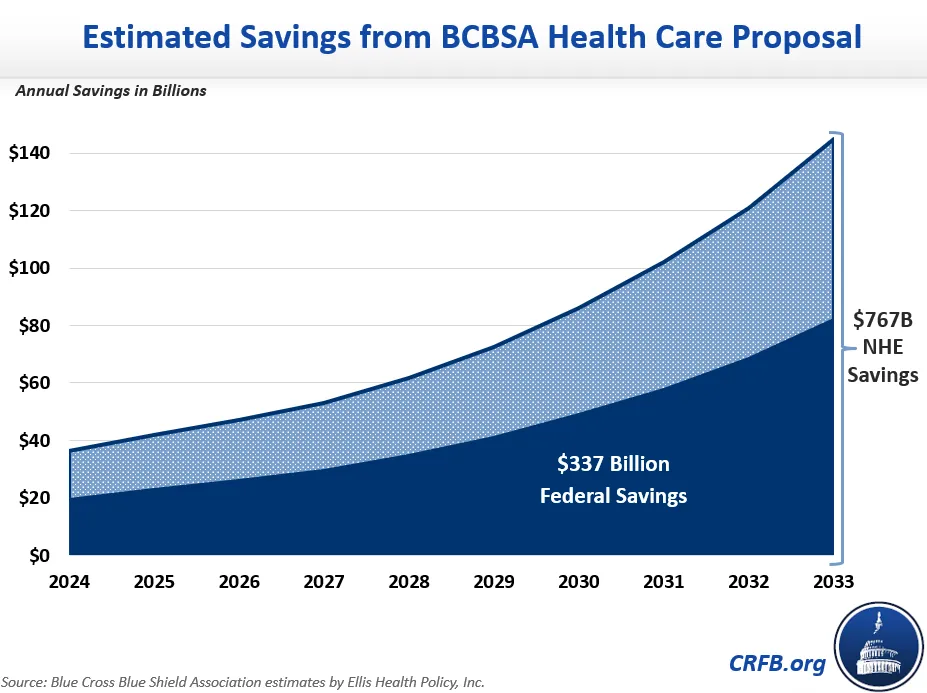BCBSA Offers Options to Reduce Health Care Costs
Recently, the Blue Cross Blue Shield Association (BCBSA) released a plan to lower health care costs that focuses primarily on reducing the high prices paid for health care in Medicare and the commercial insurance market. BCBSA estimates its plan would reduce federal deficits by $337 billion over a decade and lower overall national health expenditures (NHE) – including premiums and out-of-pocket costs – by $767 billion. The federal savings come both from a reduction in spending on government health care programs and from increased revenue as the value of the tax exclusion for commercial insurance shrinks and taxable wages increase.
Along with options to increase Medicare revenue and the many options we’ve put forward to lower costs and improve Medicare solvency, these proposals should be part of the discussion over how to fight inflation, lower deficits, and save our major trust funds.
Six Options to Lower Health Care Costs
| Policy | Federal Savings (2024-2033) | Total NHE Savings (2024-2033) |
|---|---|---|
| Adopt Site-Neutral Payment Policies in Medicare | $231 billion | $471 billion |
| Expand Antitrust Funding & Enforcement | $17 billion | $79 billion |
| Prohibit Anti-Competitive Provisions in Provider Contracts | $8 billion | $38 billion |
| Facilitate Generic Drug & Biosimilar Entry | $7 billion | $15 billion |
| Limit the Exclusivity Period for Biologicals | $41 billion | $101 billion |
| Repeal Tax Deduction for Drug Advertising | $33 billion | $63 billion |
| Total Savings | $337 billion | $767 billion |
| Memo: Preserve Drug Management & Prior Authorization Tools* | $88 billion | $405 billion |
Source: Blue Cross Blue Shield Association estimates by Ellis Health Policy, Inc. Estimates are based on calendar years.
*These savings are estimated relative to an alternative scenario where these tools would be limited or prohibited.
To target high hospital prices and consolidation, BCBSA calls for the adoption of site-neutral payments in Medicare. As we explained in our Health Savers Initiative brief on “Equalizing Medicare Payments Regardless of Site-of-Care,” it makes little sense for Medicare to pay higher rates for virtually identical services offered in a hospital versus a stand-alone clinic. Site neutrality reduces incentives for hospitals to purchase independent physician practices, which has been a key driver of market consolidation and high prices.
BCBSA also suggests strengthening antitrust enforcement of anti-competitive practices among health care providers, including by increasing the Federal Trade Commission’s budget and power over nonprofit hospitals and purchases of physician practices. In addition, the plan would prohibit anti-competitive provisions in hospital contracts.
To lower the cost of prescription drugs, the plan includes several proposals to limit or ban practices utilized by drug manufacturers to extend patents beyond the conventional 20-year protection period, including pay-for-delay, citizen petitions, and product hopping (which address a similar problem to that described in our Health Savers Initiative brief “Limiting Evergreening for Name-Brand Prescription Drugs”). The plan would also limit exclusivity periods for biological drugs in order to increase biosimilar entry into the market. Finally, it would repeal the tax deduction for direct-to-consumer drug advertisements (which are deductible as a normal business expense), which they argue leads to an "overuse of high-cost prescription medicines."
Although the BCBSA has not been independently scored by the Congressional Budget Office or the Committee for a Responsible Federal Budget, BCBSA commissioned estimates from Ellis Health Policy, which found the plan would reduce federal costs by $337 billion over a decade, including $63 billion in 2033. Most of these savings – $231 billion over ten years – come from adopting site-neutral payments in Medicare.

BCBSA estimates the proposals would also reduce commercial health care premiums by $298 billion and out-of-pocket costs by $206 billion. Accounting for interactions, BCBSA estimates the plan would lower total NHEs by $767 billion over ten years – including by $145 billion in 2033.
In addition to the six options designed to lower costs, the BCBSA plan proposes two policies it argues would protect against increases in health care costs. The first would preserve the ability of health insurers to manage their drug benefit costs through step therapy (a process where patients use cheaper alternatives before high-cost drugs) and pharmacy networks. The second would continue allowing health insurers to utilize prior authorization, where insurers determine if a service or drug is medically necessary before authorization of coverage. BCBSA estimates that preserving these tools would save the federal government nearly $90 billion over the decade and $405 billion in overall health care spending, compared to an alternative scenario where these tools would be limited or prohibited.
Along with other reforms to lower costs and raise revenue, the options provided by the Blue Cross Blue Shield Association could help to meaningfully improve our health cost and fiscal outlook and should be part of the discussion for reforms.

